Asparagus (Asparagus officinalis L. var. altilis) is a popular and nutritious vegetable belonging to the Asparagaceae family (formerly Liliaceae). The Asparagaceae in turn belongs to the monocotyledon group of angiosperms (flowering plants) (Asparagaceae - Wikipedia).
Unlike the majority of vegetables it as perennial rather than an annual plant. The harvested organs are the "spears" (young shoots) which appear in early spring from over-wintering roots.
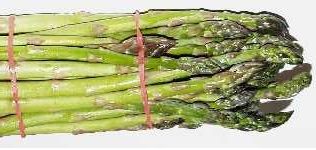
Asparagus Spears (D. Rhodes)
The word "asparagus" may derive from the Greek word "aspharagos" [ = "sprout" or "shoot"] (Asparagus - Wikipedia).
It is thought that asparagus may have originated in the coastal areas of Asia, Africa and Europe. It was extensively cultivated by the Egyptians, Greeks and Romans over 2,000 years ago. This vegetable was brought to North America by European settlers (Asparagus - Wikipedia).
Asparagus is a cool season crop and very cold hardy. It is dioecious [meaning that male and female flowers occur on separate staminate and pistillate plants, respectively]. It can be propagated from seed (harvested from female plants) or from 1-year-old crowns (roots) used as transplants. The vegetable can be first harvest after 2 or 3 years. Plantings may produce for 15 to 20 years depending upon the severity of a number of environmental and biotic factors (e.g. disease pressure, insect pressure, weed infestation, nutrient stress and drought stress). This vegetable prefers a soil pH between pH 6.0 and 7.0 and grows optimally at 16 to 24 degrees C.
Spears are typically harvested when approximately 13 to 25 cm in length. The spears are cut with a knife or snapped off by hand. Harvested spears are best stored at 3 to 4 degrees C. If not harvested, the spears develop into ferns, which are modified stems or cladophylls. The true leaves are scale-like structures at the tip of the spear and down the stem. The cladophylls develop from leaf (scale) axes and give rise to flowers.
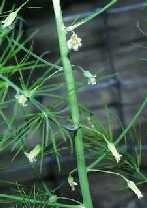
Male Asparagus Flowers (D. Rhodes)
Asparagus is insect pollinated, and the female flowers produce red berries. Male plants are more productive than female plants (presumably because they invest less photosynthate in fruit and seed production than males). Consequently breeding has emphasized the development of male varieties with disease (primarily rust) resistance. Hybrid varieties have greater vigor, disease resistance and yields than open-pollinated varieties.
It is important to note that crop rotation cannot be used to control insect pests and diseases in this vegetable because it is a perennial.
The major diseases of asparagus in the Midwest: are Fusarium crown and root rot, Cercospora leaf spot, and rust. Some varieties of asparagus have rust resistance. For Fusarium crown and root rot control it is recommended to use certified, disease-free crowns, avoid fields with a history of the disease, and carefully manage soil pH, fertility and drainage (Fusarium crown and root rot is promoted by low pH, poor drainage, and infertile soil), and use hybrids that are more tolerant to Fusarium than open-pollinated varieties.
The major insect pests of asparagus in the Midwest include, asparagus beetles (see images below of the adult, eggs and larva), cutworms, tarnished and alfalfa plant bugs, and asparagus aphids (Grafius and Hutchinson, 1995).
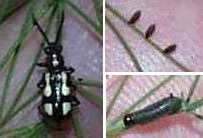
Spotted Asparagus Beetle Adult (left), eggs (upper right) and larva (lower right) (D. Rhodes)
(see: ID-56 "Midwest Vegetable Production Guide for Commercial Growers" for a description of hybrid varieties, planting, spacing, cultivating, harvesting, fertilizing, and specific disease, weed and insect control recommendations for asparagus in the Midwest of North America)
The first amino acid to be identified, asparagine, was isolated from asparagus juice in 1806 by French chemists Louis Nicolas Vauquelin and Pierre Jean Robiquet (Asparagine - Wikipedia).
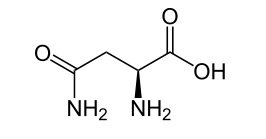
Asparagine - Wikipedia
Also the sulfur compound, asparagusic acid, was first isolated from asparagus (Asparagusic Acid (Wikipedia)). When ingested by humans, asparagus acid is degraded to the volatile sulfur compounds methane thiol and dimethyl sulfide, which are then excreted in urine. These sulfur compounds contribute to the sulfur odor of urine after eating asparagus (Eriksson et al., 2010; Pelchat et al., 2011).
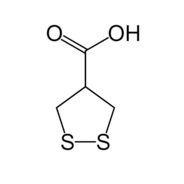
Asparagusic Acid - Wikipedia
Certain individuals are unable to sense this sulfurous odor, and these individuals appear to carry a single nucleotide polymorphism (rs4481887) within a 50-gene cluster of olfactory receptors in the human genome (Eriksson et al., 2010; Pelchat et al., 2011).
Sources of information and additional reading
• Grafius, E., Hutchinson, B. Asparagus. In "Vegetable Insect Management With Emphasis on the Midwest", (ed. R. Foster, B. Flood), Meister Publishing Co., Willoughby, Ohio, pp. 147 - 156 (1995).
• Nonnecke, I.L. "Vegetable Production", Van Nostrand Reinhold, NY (1989).
• Phillips, R., Rix, M. "The Random House Book of Vegetables", Random House, NY (1993).
• Maynard, D.N. Asparagus. In "The Software Toolworks Multimedia Encyclopedia", Version 1.5, Grolier, Inc. (1992).
• ID-56 Midwest Vegetable Production Guide for Commercial Growers (updated yearly): https://ag.purdue.edu/btny/midwest-vegetable-guide/Pages/default.aspx
• Kotecha, P.M., Kadam, S.S. Asparagus. In "Handbook of Vegetable Science and Technology: Production, Composition, Storage, and Processing", (ed. D.K. Salunkhe, S.S. Kadam), Marcel Dekker, Inc., NY, pp. 511 - 521 (1998).
• Asparagaceae - Wikipedia https://en.wikipedia.org/wiki/Asparagaceae
• Asparagus - Wikipedia: https://en.wikipedia.org/wiki/Asparagus
• Asparagine - Wikipedia: https://en.wikipedia.org/wiki/Asparagine
• Asparagusic Acid - Wikipedia: https://en.wikipedia.org/wiki/Asparagusic_acid
• Pelchat, M.L., Bykowski, C., Duke, F.F., Reed, D.R. Excretion and Perception of a Characteristic Odor in Urine after Asparagus Ingestion: a Psychophysical and Genetic Study. Chem. Senses. 36(1): 9–17 (2011): https://www.ncbi.nlm.nih.gov/pmc/articles/PMC3002398/
• Eriksson, N., Macpherson, J.M., Tung, J.Y., Hon, L.S., Naughton, B., Saxonov, S., Avey, L., Wojcicki, A., Peer, I., Mountain, J. Web-Based, Participant-Driven Studies Yield Novel Genetic Associations for Common Traits. PLoS Genet 6(6): e1000993 (2010): https://www.ncbi.nlm.nih.gov/pmc/articles/PMC2891811/
• Rhodes, D. Definitions of vegetables, herbs and spices - steemit: https://steemit.com/vegetables/@davidrhodes124/definitions-of-vegetables-herbs-and-spices
Very interesting! In 2010 23 and me asked around 9,000 of their clients
Let's do an experiment and see if steemit members can replicate their results. So I'll ask the question again:
“Have you ever noticed a specific odor when you pee after eating asparagus?”
My answer is: YES!
How will you answer?
Downvoting a post can decrease pending rewards and make it less visible. Common reasons:
Submit
Yes!
Downvoting a post can decrease pending rewards and make it less visible. Common reasons:
Submit
Definitely
Downvoting a post can decrease pending rewards and make it less visible. Common reasons:
Submit
Definately one of my favourite veggies, tastes great lathered in real butter. good post, very informative. i left you a vote and a folllow if you also enjoy reading gardening blogs, check mine out, i write about gardening too
Downvoting a post can decrease pending rewards and make it less visible. Common reasons:
Submit
Thanks, I am now following you. Glad to make contact with other gardeners.
Downvoting a post can decrease pending rewards and make it less visible. Common reasons:
Submit
judging by your profile, and degree, you will have more knowledge then me haha
Downvoting a post can decrease pending rewards and make it less visible. Common reasons:
Submit
I think pottering around the garden in retirement is much more fun than academia and the constant quest for grants and publications. The best part was teaching and interacting with students. I hope to continue sharing what knowledge I have acquired here on steemit. But I am always looking for new information and insight! Cheers.
Downvoting a post can decrease pending rewards and make it less visible. Common reasons:
Submit